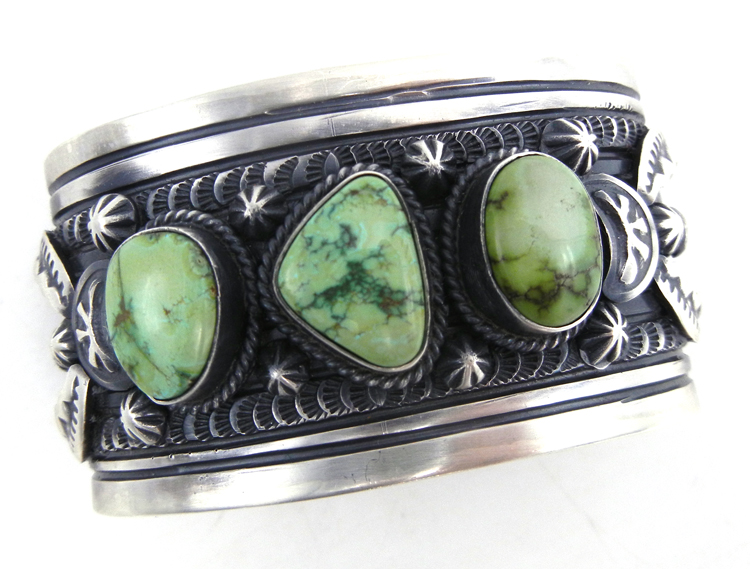Turquoise has been a cherished stone for centuries, not only for its natural beauty but also for its special meanings and rich history.
However, those looking to own an authentic piece of turquoise jewelry are often confronted with the challenge of discerning genuine turquoise from well-crafted fakes, especially in light of the prevalent myth that real turquoise possesses magnetic properties.
At Palms Trading Company, we’re dedicated to guiding our customers through the world of genuine turquoise. Trust our expert team to help you find a piece of real turquoise jewelry that is as authentic as it is beautiful.
In this blog post, we’ll delve into the scientific composition of turquoise, debunk the magnetic myth, and provide guidance on identifying genuine turquoise and caring for it.
Unraveling the Mystery: The Composition of Real Turquoise
Genuine turquoise is primarily made up of copper, aluminum, phosphate, water, and oxygen. The gorgeous color spectrum of turquoise, ranging from sky blue to green, directly results from varying copper and iron contents.
What makes turquoise unique is its distinct particle arrangement, similar to a carefully designed brick pattern. This structure inherently lacks magnetic properties, as it does not contain elements like iron, nickel, or cobalt, which are essential for magnetism.
This insight into the stone’s chemical and physical makeup is crucial for both gem enthusiasts and professionals in distinguishing genuine turquoise from imitations.
Debunking the Misconception: Dissecting the Myth of Magnetic Turquoise
The myth surrounding magnetic turquoise stems from a lack of understanding of its intrinsic properties. Turquoise, devoid of ferromagnetic elements in its composition, cannot be magnetic.
Gemology experts have consistently validated this through various scientific tests and examinations. Any magnetic reaction in a stone sold as turquoise would indicate the presence of foreign materials, not the turquoise itself.
This misconception is often perpetuated by misleading claims and the circulation of counterfeit stones in the market, leading to confusion among consumers.
Exploring Magnetic Imposters: Identifying Fake Turquoise and Its Magnetic Traits
Counterfeit turquoise is a significant contributor to the magnetic turquoise myth. Common materials used to mimic turquoise include dyed howlite or magnesite, which can sometimes be infused with magnetic substances to alter their weight or appearance.
While visually similar, these imitations can exhibit magnetic properties if they contain iron or other magnetic elements. This practice has led to widespread confusion and misinformation.
When purchasing turquoise stones or pieces of jewelry, buyers should exercise caution, looking for signs such as exceptionally low prices or lack of proper authentication, which are red flags indicating possible counterfeits.
The Authenticity Test: How to Tell if Turquoise Jewelry Is Real
Learning how to identify real or fake turquoise is essential for any collector or enthusiast. Simple testing methods like the ‘scratch test’ can provide initial insights. Genuine turquoise has a Mohs hardness rating of 5-6 and should not be easily scratched.
The hot needle test is another method where a heated needle is gently pressed against the stone. Genuine turquoise will not melt or produce a plastic-like odor, a sign typically associated with synthetic materials.
However, these home tests should be supplemented with professional evaluation for conclusive results. Seeking the expertise of a certified gemologist is the most reliable approach to authenticating turquoise, as they employ advanced tools and masterful techniques to determine the stone’s genuineness accurately.
Preserving the Beauty: Care Tips for Maintaining Authentic Turquoise Jewelry
Maintaining the beauty and integrity of genuine turquoise jewelry requires specific care and attention. Turquoise should be cleaned gently with a soft, damp cloth, avoiding harsh chemicals or abrasive materials that can damage its surface.
Proper storage is crucial; turquoise should be kept separately from harder stones to prevent scratches. While real turquoise stones aren’t magnetic, it’s advisable to keep them away from strong magnetic fields, which could affect their structural integrity over time.
Additionally, exposure to direct sunlight and extreme temperatures should be avoided to preserve the stone’s vibrant green and blue colors and prevent any potential damage to its structure. We suggest storing turquoise jewelry in separate zip-top baggies. By adhering to these care guidelines, owners can ensure that their turquoise necklaces, earrings, or bracelets remain stunning and cherished for years to come.
Find Real Turquoise Jewelry for Sale at Palms Trading Company
At Palms Trading Company, we guarantee the authenticity of every item, a promise underpinned by our personal relationships with Native American artists. Most pieces in our collection of turquoise jewelry, including real turquoise rings, necklaces, and bracelets, are acquired directly from these skilled artisans or their close relatives.
Our commitment to sharing our in-depth knowledge about these artists and their work enhances the shopping experience, both online and in-store. With decades of experience in buying and selling a wide variety of exquisite creations, we also possess unparalleled expertise in evaluating the authenticity of antique Native American jewelry.
With the exceptional services of our personal shoppers, you can explore selections from specific artists with ease. Contact us today to learn more about our treasure trove of genuine, handcrafted Native American turquoise jewelry.



